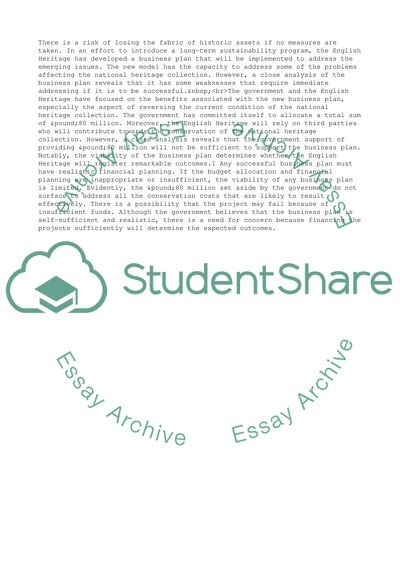Cite this document
(“The English Heritage New Model Essay Example | Topics and Well Written Essays - 1750 words”, n.d.)
The English Heritage New Model Essay Example | Topics and Well Written Essays - 1750 words. Retrieved from https://studentshare.org/business/1697120-critically-assess-the-english-heritage-business-plan-provided-to-the-dcms-in-2014-you-should-comment-on-the-main-areas-you-see-as-potential-weaknesses-to-the-plan
The English Heritage New Model Essay Example | Topics and Well Written Essays - 1750 words. Retrieved from https://studentshare.org/business/1697120-critically-assess-the-english-heritage-business-plan-provided-to-the-dcms-in-2014-you-should-comment-on-the-main-areas-you-see-as-potential-weaknesses-to-the-plan
(The English Heritage New Model Essay Example | Topics and Well Written Essays - 1750 Words)
The English Heritage New Model Essay Example | Topics and Well Written Essays - 1750 Words. https://studentshare.org/business/1697120-critically-assess-the-english-heritage-business-plan-provided-to-the-dcms-in-2014-you-should-comment-on-the-main-areas-you-see-as-potential-weaknesses-to-the-plan.
The English Heritage New Model Essay Example | Topics and Well Written Essays - 1750 Words. https://studentshare.org/business/1697120-critically-assess-the-english-heritage-business-plan-provided-to-the-dcms-in-2014-you-should-comment-on-the-main-areas-you-see-as-potential-weaknesses-to-the-plan.
“The English Heritage New Model Essay Example | Topics and Well Written Essays - 1750 Words”, n.d. https://studentshare.org/business/1697120-critically-assess-the-english-heritage-business-plan-provided-to-the-dcms-in-2014-you-should-comment-on-the-main-areas-you-see-as-potential-weaknesses-to-the-plan.


